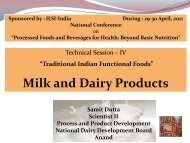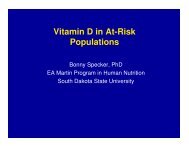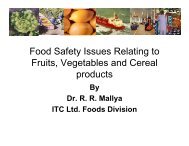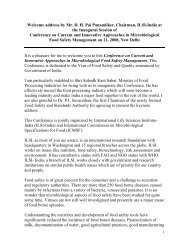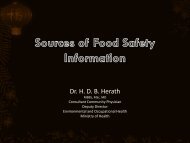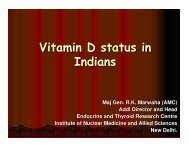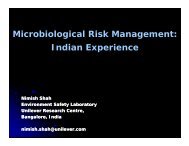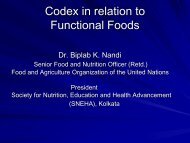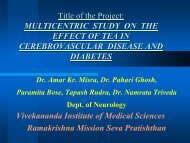Markers-Assisted Selection for Plant Breeding - ILSI India
Markers-Assisted Selection for Plant Breeding - ILSI India
Markers-Assisted Selection for Plant Breeding - ILSI India
You also want an ePaper? Increase the reach of your titles
YUMPU automatically turns print PDFs into web optimized ePapers that Google loves.
<strong>Markers</strong>-<strong>Assisted</strong> <strong>Selection</strong><br />
<strong>for</strong><br />
<strong>Plant</strong> <strong>Breeding</strong><br />
P. K. Gupta<br />
Molecular Biology Laboratory<br />
Department of Agricultural Botany<br />
Ch.Charan Singh University, Meerut
MAS vs Transgenics<br />
• MAS should be preferred over transgenic, if<br />
genetic variation is available in gene pool<br />
• MAS is also desirable, if visual selection is<br />
difficult & cost/time ineffective<br />
• Sometimes, both approaches are used<br />
(e.g. insect/disease resistance in rice)
Marker-<strong>Assisted</strong> <strong>Selection</strong> <strong>for</strong><br />
Conventional <strong>Breeding</strong>: Why?<br />
- Difficult traits (e.g.,abiotic stresses)<br />
- Traits with low heritability<br />
- Pyramiding of resistance genes<br />
- <strong>Selection</strong> at seedling stage<br />
- Distinguish homo- & heterozygotes<br />
- No question of biosafety and bioethics
Steps Involved in MAS<br />
• Development of trait-associated markers<br />
• <strong>Selection</strong> of markers (relative contribut’n)<br />
• Validation of markers (breeding material)<br />
• Utilization of markers (several methods)<br />
• Simultaneous marker develop’t & utilizat’n<br />
(e.g. AB-QTL; ‘mapping-as-you-go’)
Marker Polymorphism <strong>for</strong> MAS
Marker-<strong>Assisted</strong> Backcrossing<br />
Transfer of genes from DG to RG<br />
- Foreground selection (<strong>for</strong> donor’s trait)<br />
- Background selection (<strong>for</strong> host genome)<br />
(i) 2 step selection (chromosome, genome)<br />
(ii) 3-4 step selection (gene region arm<br />
chromosome genome)
Restricted Backcrossing &<br />
Double Haploidy (DH) <strong>for</strong> MAS<br />
• BC 1 F 1 pollen <strong>for</strong> haploids<br />
-gene selection at the haploid stage<br />
-background selection of DHs<br />
• gain over phenotypic selection, and cost<br />
reduced by 40%<br />
(Molecular <strong>Breeding</strong> 2005)
Some Novel Strategies<br />
(<strong>for</strong> complex & multiple traits)<br />
• Marker-assisted recurrent selection (MARS)<br />
and genome-wide selection (GWS)<br />
• AB-QTL: transfer of several traits:<br />
Tanksley & Nelson (1996) TAG 92:191<br />
• Introgr’n Lines (ILs) <strong>for</strong> gene pyramid’g<br />
Zamir (2001) Nat Rev Gen; Ashikari &Matsuoka (2006) Trends Pl Sci<br />
• <strong>Breeding</strong> by Design TM<br />
Peleman & van der Voort (2003) Trends <strong>Plant</strong> Sci 8:330
Achievements of MAS<br />
(details not being discussed)<br />
• MAS Programs World-Wide: USA,<br />
Canada, Australia, CIMMYT, IRRI -<br />
Many Cultivars Released<br />
• MAS in <strong>India</strong>: Cultivars Released<br />
-1. Rice (Improved PB-1; Improved<br />
Sambha Mahsuri; 2. Pearl-millet<br />
(HHB-67-2); 3. Maize (Vivek-QPM9)<br />
• Submergence tolerance: Sub1A
60 Genes/QTL <strong>for</strong> MAS in Wheat<br />
(Gupta et al. 2009, Mol <strong>Breeding</strong>)<br />
A<br />
1 2 3 4 5 6 7<br />
QGw.ccsu-1A.1<br />
(1AS-5 0.20)<br />
Glu-A1<br />
(1AL1-0.17-0.61)<br />
Lr46<br />
QGw.ccsu-1A.3<br />
(1AL3-0.61-1.00)<br />
Lr37/Yr17/Sr38<br />
(2AS5-0.78-1.00)<br />
Bx7, Cre 493<br />
PPO (2AL0.77-0.85)<br />
QFhs.ndsu-3AS<br />
(3AS4-0.45-1.00)<br />
QPhs.ccsu-3A.1<br />
(3AL5-0.78-1.00)<br />
PHS, GBSS Null<br />
Yr34 (5AL23-0.87-1.00)<br />
Sr26<br />
GBSS Null<br />
Lr47<br />
(7AS-6 0.21)<br />
Flour Color<br />
Sr22 (7AL 0.83-1.00)<br />
B<br />
Yr10,Yr15,Glu-3<br />
(1BS.sat18-0.50-1.00)<br />
1B/1R<br />
Glu-B1(1BL1-0.47-0.69)<br />
Lr46<br />
(1BL 0.84-0.89)<br />
Lr13/23<br />
Cre1<br />
(2BL 0.50-0.89)<br />
Sr2,Fhb1(3BS-0.78-1)<br />
Rht1(4BS8-0.57-0.81)<br />
Sr36, Sr32,<br />
Sr39/Lr35,<br />
Lr46/Yr29 Cr Yls<br />
Qss.msub-3BL<br />
(3BL-0.81-1.00)<br />
BGGP<br />
GPC-B1,Yr36<br />
(6BS-5 0.49-0.68)<br />
Cre8<br />
Lr9 (6BL-0.79-1.00)<br />
Yfc, Rlnn1, Bo1, LMA<br />
Rht8<br />
(C-2DS 0.47-1.00)<br />
Sr33<br />
Rht2 (4DS3-0.67-0.82)<br />
PinA (5DS7-0.67-0.78)<br />
Lr34/Yr18 (7DS-4 0.61-1.00)<br />
Stb4<br />
D<br />
Glu-D1<br />
(1DL2-0.41-1.00)<br />
Cre3, PPO<br />
(2DL9-0.76-1.00)<br />
Lr24 (3DL-0.78-<br />
Sr24 1) (3DL2-0.27-0.81)<br />
Almt-1<br />
(4DL 0.71–0.86)<br />
Sr30, Lr1<br />
Pch1, Lr19/Sr25,<br />
GBSS Null<br />
Bdv2 (7DS-8 0.77-1.00)<br />
Figure 1
MAS in Cereals<br />
• Maize, Wheat, Barley (CIMMYT,<br />
USA, Australia, Canada)<br />
• <strong>Markers</strong> <strong>for</strong> genes <strong>for</strong> all major traits<br />
(>20 in each case) except yield and<br />
abiotic stresses being used <strong>for</strong> MAS:<br />
-insect -pest resistance, protein<br />
quality, & other agronomic traits
Gene-<strong>Assisted</strong> selection (GAS) <strong>for</strong><br />
Bread Making Quality<br />
Objective: provide an integrated manipulation of bread<br />
making characteristics using molecular markers<br />
Molecular markers<br />
<strong>for</strong> gluten strength<br />
STS <strong>for</strong> Glu-1<br />
New varieties<br />
Molecular markers<br />
<strong>for</strong> hardness<br />
SNPs <strong>for</strong> Pinb-D1<br />
Molecular markers <strong>for</strong><br />
grain protein content<br />
CAPS <strong>for</strong> Gpc-B1
MAS <strong>for</strong> Blight and Blast of Rice<br />
Bacterial Blight<br />
Blast Disease
Pyramiding Xa Genes <strong>for</strong> Bacterial<br />
Blight Resistance in Rice<br />
• ‘Angke’ & ‘Conde’ (Indonesian cultivars) xa5 in<br />
the background of xa4<br />
Toennissen et al. (2003) Curr Opin <strong>Plant</strong> Biol 6:191-198<br />
• PR106 (PAU) & MH2R<br />
xa5 (xa5+xa13+Xa21)<br />
(Mahyco Res. Ctr, Jalna)<br />
Singh et al. 2001. TAG (PR106 × IRBB62 xa5 + xa13 + Xa21 ); Mahyco<br />
(MH2R xa5 × IRBB60 Xa4+xa5+xa13+Xa21 )<br />
• PB-1(with basmati quality) with BB resistance<br />
(from IRBB55 xa13+Xa21 ) at IARI<br />
Joseph et al. 2004. Mol Breed 13:377<br />
• Improved Sambha Mahshuri: BLB genes xa5,<br />
xa13, Xa21; donor PR 106; DRR, Hyderabad
Improved Samba Mahsuri (IET 19046)<br />
A first variety from Marker <strong>Assisted</strong> <strong>Selection</strong> (MAS)
Bacterial Blight in Rice
Pyramiding of Genes <strong>for</strong> Blast<br />
Resistance in Rice<br />
• Pi-2(t)+Pi-9(t) in ‘Kalinga III’ &‘Vandana’<br />
(CRRI) * *C101A51 Pi-2(t) & O. minuta Pi-9(t) ;<br />
Pi-1(Pi1)+Pi-2(Piz-5)+Pi-4(Pita) in ‘CO39’<br />
(UAS, Bangalore)<br />
LAC23 Pi-1 , 5173 Pi-2 & Pai-kan-tao Pi-4 → CO39 = CO39 Pi-1+Pi-2+Pi-4<br />
(Hittalmani et al. 2000. TAG 100:1121–1128); *alleles indicated in parenthesis<br />
‘IR50’, ‘Jyothi’(Madras Univ), ‘IR36’, IR50, ‘IR64’ & ‘IR72’<br />
(UAS; Hittalmani 2005)
Resistance <strong>for</strong> Rice Blast Disease
Submergence Tolerance in Rice<br />
Swarna- Sub1A (Nature, Aug ’06)<br />
BC3F2, BC2F3<br />
Sub1 donor<br />
IR49830<br />
Swarna<br />
six varieties* close to<br />
release at national &<br />
state levels in<br />
Bangladesh & <strong>India</strong><br />
*Swarna, IR64,CR1009,<br />
BR11, TDK1, Samba Mahsuri
Marker <strong>Assisted</strong> Resistance <strong>Breeding</strong><br />
Some Often Cited Examples<br />
• Soybean Cyst Nematode<br />
Cregan et al. 2000; Meksem et al., 2001<br />
• Resistance against Gall Midge in Rice<br />
Madan Mohan (ICGEB; Now at UDSC)<br />
Two Hybrids Released in <strong>India</strong><br />
• Pearl-millet (HHB-67-2 from HHB-67 (HAU)<br />
(downy mildew resistant): ICRISAT<br />
• Maize (Vivek-QPM9): VPKAS, Almora<br />
Hybrid Rice Cultivars in China<br />
(e.g., Shanyou 63; Restorer Line Minghui 63 Improved)
Gene Pyramiding <strong>for</strong> Biotic &<br />
Abiotic Stresses in Barley<br />
• South Aust. Barley Impr. Program (SABIP)<br />
- CCN (Ha2/Ha4), BYDV (Yd2), SFNB (Rpt4) &<br />
Mn effi.(Mel1) -‘Sloop’ → ‘Sloop SA’;‘Sloop Vic’<br />
Source: Chebec(Ha2), Franklin (Yd2) & Keel (Ha4, Rpt4 & Mel1)<br />
- CCN, SFNB, leaf rust, leaf scald, boron tol. &<br />
thermostable β-amylase to ‘Gairdner’<br />
Source: 1.‘Keel’– CNN & SFNB resistance, 2. ‘Fanfare’- rust resistance, 3. H. spontaneum<br />
- scab resistance, 4. ‘DH115’ – boron tolerance & 5. SD3 - thermostable β-amylase<br />
SFNB, Spot Form Net Blotch
Problems in MAS <strong>for</strong> Yield:<br />
Maize/Rice/Tomato/Barley<br />
• Limited success: 20 QTLs in maize † , 2<br />
QTLs in rice ‘9311’ * & 3 QTLs in tomato ** ;<br />
† M. Edwards, Monsanto, St. Louis, USA *O. rufipogon ‘RGC105491’ to O. sativa ‘9311’<br />
(Liang et al. 2004, Euphytica); ** Crossing ILs (S. pennellii → S. lycopersicum ‘M82’),<br />
Gur & Zamir (2004) PLoS Biol 2:e245<br />
• No benefit (epistasis & env.): QTL from<br />
‘Steptoe’ (high yield) & ‘Morex’ (malting) in<br />
Barley → 10 Morex NILs & 1 Steptoe NIL<br />
(Kandemir et al., 2000 Mol Breed 6:157)
Pyramiding Additional Genes<br />
Over Transgenes<br />
• Rice: ‘CO39’NIL Piz-5 →IR50 Piz-5 → trans<strong>for</strong>m Xa21 =<br />
IR50 Piz-5+Xa21 (Crop Sci 42:p2072, 2002)<br />
• Rice: IRBB21 Xa21 → Minghui 63 Xa21 (MAS) × Minghui<br />
63 cry1Ab+cry1Ac (GM) = Minghui 63<br />
cry1Ab+ cry1Ac+Xa21<br />
(Minghui 63 is a widely used cms restorer line <strong>for</strong> hybrid rice in<br />
China)<br />
(Jiang et al. 2004 <strong>Plant</strong> Breed 123:112-116)<br />
• Soybean: QTL <strong>for</strong> insect resistance from ‘PI<br />
229358’ to GM ‘Jack-Bt’ cry1Ac<br />
(Walker et al. 2002; Mol Breed 9:43)
Reasons <strong>for</strong> Low Impact &<br />
Future Needs <strong>for</strong> MAS<br />
• Non-availability of robust markers<br />
• Epistasis, background and g × e<br />
• Still cost-ineffective: high throughput & low<br />
cost genoytpic centres needed<br />
• <strong>Plant</strong> breeder-molecular biologist gap<br />
• Association mapping needed<br />
• MARS & GWS <strong>for</strong> complex/multiple traits
Further Reading on MAS<br />
• Gupta et al. (2009). MAS <strong>for</strong> conventional<br />
plant breeding. <strong>Plant</strong> Breed Rev 33:145-217<br />
• Gupta et al. (2009). MAS in Wheat: Mol<br />
<strong>Breeding</strong> (Special Issue): 24: (published online,<br />
11 December, 2009)<br />
• Gupta et al. (2009). MAS <strong>for</strong> complex and<br />
multiple traits in crops. (under preparation)<br />
• Several Other Reviews on this Active Area




